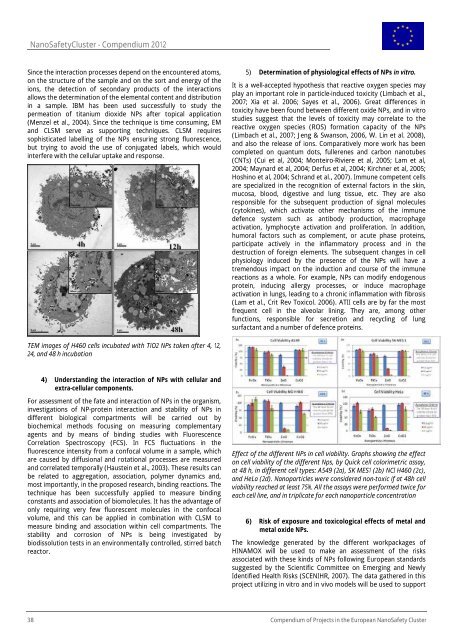Timing, hosts and locations of (grouped) events of NanoImpactNet
Timing, hosts and locations of (grouped) events of NanoImpactNet
Timing, hosts and locations of (grouped) events of NanoImpactNet
Create successful ePaper yourself
Turn your PDF publications into a flip-book with our unique Google optimized e-Paper software.
NanoSafetyCluster - Compendium 2012<br />
Since the interaction processes depend on the encountered atoms,<br />
on the structure <strong>of</strong> the sample <strong>and</strong> on the sort <strong>and</strong> energy <strong>of</strong> the<br />
ions, the detection <strong>of</strong> secondary products <strong>of</strong> the interactions<br />
allows the determination <strong>of</strong> the elemental content <strong>and</strong> distribution<br />
in a sample. IBM has been used successfully to study the<br />
permeation <strong>of</strong> titanium dioxide NPs after topical application<br />
(Menzel et al., 2004). Since the technique is time consuming, EM<br />
<strong>and</strong> CLSM serve as supporting techniques. CLSM requires<br />
sophisticated labelling <strong>of</strong> the NPs ensuring strong fluorescence,<br />
but trying to avoid the use <strong>of</strong> conjugated labels, which would<br />
interfere with the cellular uptake <strong>and</strong> response.<br />
TEM images <strong>of</strong> H460 cells incubated with TiO2 NPs taken after 4, 12,<br />
24, <strong>and</strong> 48 h incubation<br />
4) Underst<strong>and</strong>ing the interaction <strong>of</strong> NPs with cellular <strong>and</strong><br />
extra-cellular components.<br />
For assessment <strong>of</strong> the fate <strong>and</strong> interaction <strong>of</strong> NPs in the organism,<br />
investigations <strong>of</strong> NP-protein interaction <strong>and</strong> stability <strong>of</strong> NPs in<br />
different biological compartments will be carried out by<br />
biochemical methods focusing on measuring complementary<br />
agents <strong>and</strong> by means <strong>of</strong> binding studies with Fluorescence<br />
Correlation Spectroscopy (FCS). In FCS fluctuations in the<br />
fluorescence intensity from a confocal volume in a sample, which<br />
are caused by diffusional <strong>and</strong> rotational processes are measured<br />
<strong>and</strong> correlated temporally (Haustein et al., 2003). These results can<br />
be related to aggregation, association, polymer dynamics <strong>and</strong>,<br />
most importantly, in the proposed research, binding reactions. The<br />
technique has been successfully applied to measure binding<br />
constants <strong>and</strong> association <strong>of</strong> biomolecules. It has the advantage <strong>of</strong><br />
only requiring very few fluorescent molecules in the confocal<br />
volume, <strong>and</strong> this can be applied in combination with CLSM to<br />
measure binding <strong>and</strong> association within cell compartments. The<br />
stability <strong>and</strong> corrosion <strong>of</strong> NPs is being investigated by<br />
biodissolution tests in an environmentally controlled, stirred batch<br />
reactor.<br />
5) Determination <strong>of</strong> physiological effects <strong>of</strong> NPs in vitro.<br />
It is a well-accepted hypothesis that reactive oxygen species may<br />
play an important role in particle-induced toxicity (Limbach et al.,<br />
2007; Xia et al. 2006; Sayes et al., 2006). Great differences in<br />
toxicity have been found between different oxide NPs, <strong>and</strong> in vitro<br />
studies suggest that the levels <strong>of</strong> toxicity may correlate to the<br />
reactive oxygen species (ROS) formation capacity <strong>of</strong> the NPs<br />
(Limbach et al., 2007; Jeng & Swanson, 2006, W. Lin et al. 2008),<br />
<strong>and</strong> also the release <strong>of</strong> ions. Comparatively more work has been<br />
completed on quantum dots, fullerenes <strong>and</strong> carbon nanotubes<br />
(CNTs) (Cui et al, 2004; Monteiro-Riviere et al, 2005; Lam et al,<br />
2004; Maynard et al, 2004; Derfus et al, 2004; Kirchner et al, 2005;<br />
Hoshino et al, 2004; Schr<strong>and</strong> et al., 2007). Immune competent cells<br />
are specialized in the recognition <strong>of</strong> external factors in the skin,<br />
mucosa, blood, digestive <strong>and</strong> lung tissue, etc. They are also<br />
responsible for the subsequent production <strong>of</strong> signal molecules<br />
(cytokines), which activate other mechanisms <strong>of</strong> the immune<br />
defence system such as antibody production, macrophage<br />
activation, lymphocyte activation <strong>and</strong> proliferation. In addition,<br />
humoral factors such as complement, or acute phase proteins,<br />
participate actively in the inflammatory process <strong>and</strong> in the<br />
destruction <strong>of</strong> foreign elements. The subsequent changes in cell<br />
physiology induced by the presence <strong>of</strong> the NPs will have a<br />
tremendous impact on the induction <strong>and</strong> course <strong>of</strong> the immune<br />
reactions as a whole. For example, NPs can modify endogenous<br />
protein, inducing allergy processes, or induce macrophage<br />
activation in lungs, leading to a chronic inflammation with fibrosis<br />
(Lam et al., Crit Rev Toxicol. 2006). ATII cells are by far the most<br />
frequent cell in the alveolar lining. They are, among other<br />
functions, responsible for secretion <strong>and</strong> recycling <strong>of</strong> lung<br />
surfactant <strong>and</strong> a number <strong>of</strong> defence proteins.<br />
Effect <strong>of</strong> the different NPs in cell viability. Graphs showing the effect<br />
on cell viability <strong>of</strong> the different Nps, by Quick cell colorimetric assay,<br />
at 48 h, in different cell types: A549 (2a), SK MES1 (2b) NCI H460 (2c),<br />
<strong>and</strong> HeLa (2d). Nanoparticles were considered non-toxic if at 48h cell<br />
viability reached at least 75%. All the assays were performed twice for<br />
each cell line, <strong>and</strong> in triplicate for each nanoparticle concentration<br />
6) Risk <strong>of</strong> exposure <strong>and</strong> toxicological effects <strong>of</strong> metal <strong>and</strong><br />
metal oxide NPs.<br />
The knowledge generated by the different workpackages <strong>of</strong><br />
HINAMOX will be used to make an assessment <strong>of</strong> the risks<br />
associated with these kinds <strong>of</strong> NPs following European st<strong>and</strong>ards<br />
suggested by the Scientific Committee on Emerging <strong>and</strong> Newly<br />
Identified Health Risks (SCENIHR, 2007). The data gathered in this<br />
project utilizing in vitro <strong>and</strong> in vivo models will be used to support<br />
38 Compendium <strong>of</strong> Projects in the European NanoSafety Cluster






